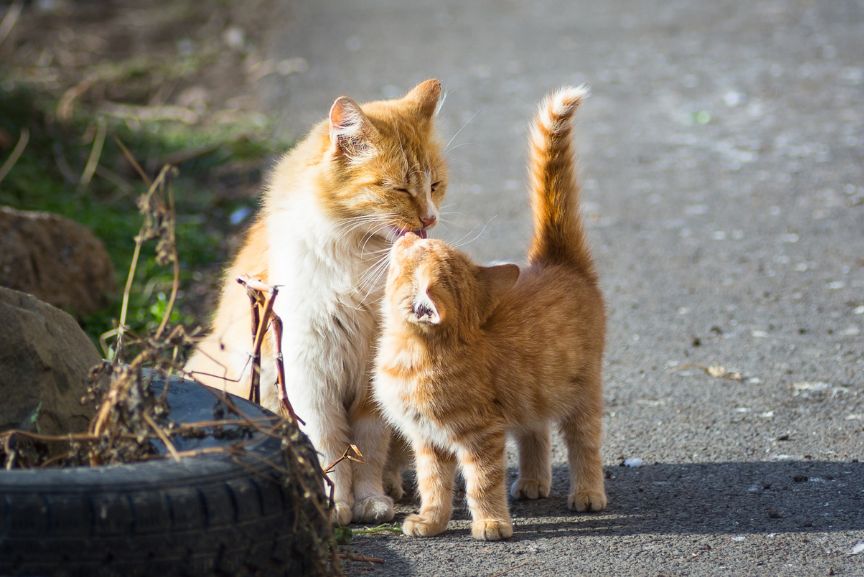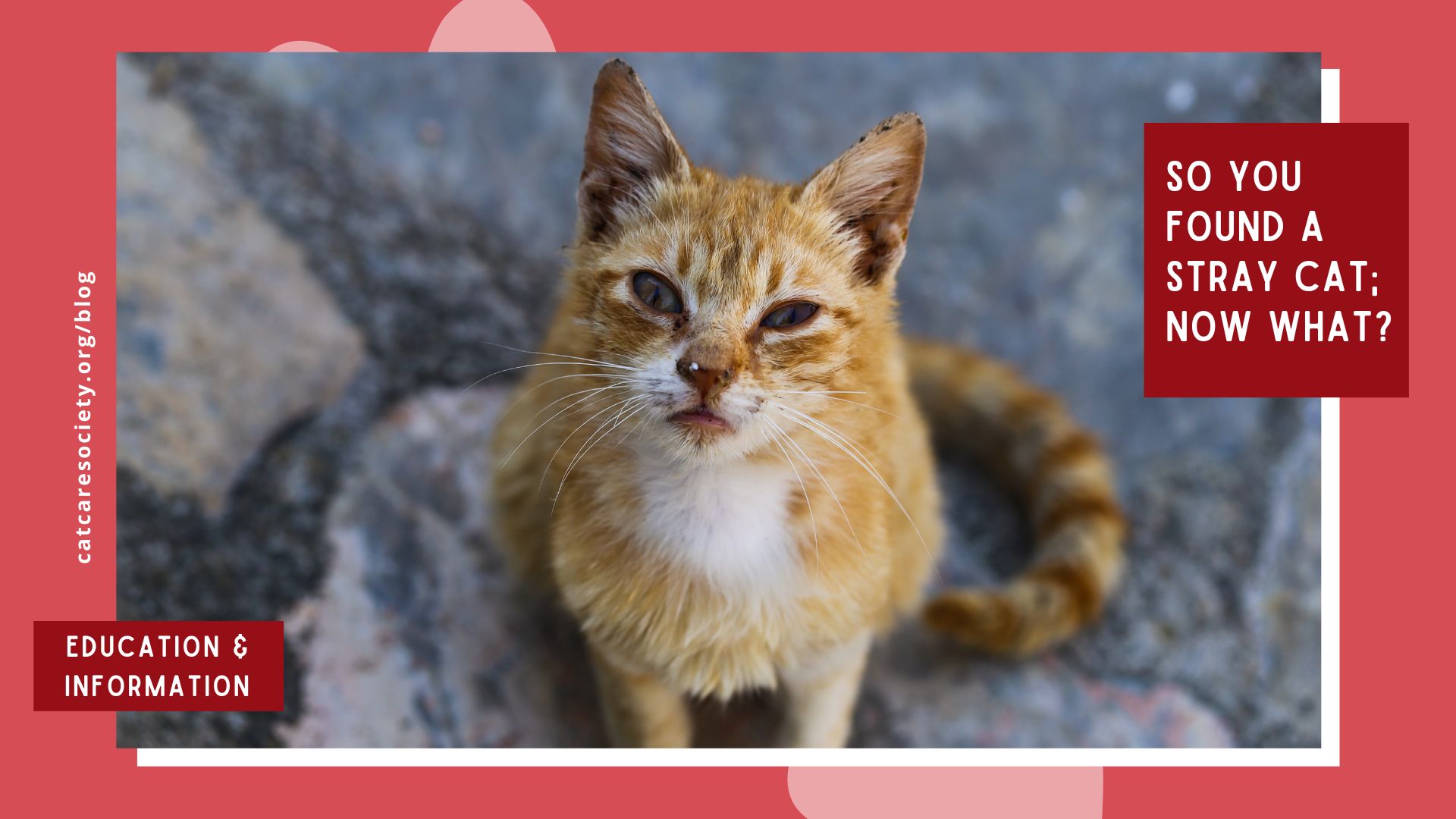If you’ve ever come across a cat outdoors, you likely felt the urge to help. While there are situations where human intervention is necessary for a found cat or kitten, often the best course of action is to leave it be! That may be surprising, but research has found that around 75% of lost cats find their way home on their own, but less than 2% of cats without microchips are reclaimed from a shelter. If the cat is accustomed to outdoor living and is part of a cat colony, attempting to catch it could pose risks to you, the cat, and any shelter you take it to. Throughout this article, we’ll explore how to evaluate the best way to help a cat or kitten to ensure it has the best possible outcome.
Determine the Cat’s Status: Stray, Feral/Community, or Outdoor Pet Cat
The first step is to always determine whether the cat is a stray, feral/community cat, or an outdoor pet cat with a home that’s just out on a little adventure.
- Stray cats are socialized to people but have been abandoned, lost or are otherwise living without a permanent home.
- Community cats is a general term for cats who live outdoors without a traditional owner. They may or may not be social. They may have a caretaker who provides basic medical needs and sometimes food.
- Feral cats (a type of community cat) are unsocialized to humans and typically prefer outdoor living; they often belong to a colony of cats, and feel most comfortable in that environment.
- Outdoor pet cats have a home and live an indoor/outdoor lifestyle, so they are not considered lost or abandoned.
It can be easy to assume the worst case scenario for the cat—that it has been abandoned and is vulnerable—but it’s important to stick to the facts and use the clues and information available to choose the best way to help. Sometimes, acting too soon can lead to unforeseen, negative consequences.
Read on to find out the most suitable actions for each situation, including encountering kittens, which involves different considerations.
How to Determine the Cat’s Status
EC Michaels, executive director of Cat Care Society, shares this insight about helping found cats: “There tends to be two schools of thought when it comes to what to do with found cats — one is to not touch them and leave them alone and the other to scoop them up and bring them to a shelter. We fall somewhere in the middle. A lot of community cats are social, but it’s unlikely that if they’ve lived the majority of their lives outdoors, that they would thrive living inside. More than anything, I encourage people to take a moment to assess the specific cat and the situation before acting. Consider if it is injured, if you’ve seen the cat before, if their ear is tipped, if they look healthy, and if there is a cat colony nearby. There are so many variables to take into consideration before knowing which path to take.”
Outdoor Pet Cat
Approach the cat calmly and slowly. Even if it’s socialized, it might be scared due to its surroundings, so it may take a little time to evaluate if the cat seems friendly with humans. If the cat looks healthy and approachable and you suspect that the cat is an indoor/outdoor cat, consider attaching a paper collar to get in touch with the owner or other neighbors and ease any concerns you have about it being lost.
It’s important to note that feral and community cats may also appear healthy, as they are accustomed to outdoor living. Refer to the Feral and Community Cats section later in this article to learn more about how to best support these cats, as it’s often best to leave them be.
If you lost your own cat, try out these tips from Petco.
Want more cat content in your inbox?
Cute cat pics, advice and CCS events and updates await in our weekly(ish) Mewsletter.
Stray Cats
If the cat appears to be ill or injured, you suspect it is lost or has been abandoned, and you can safely pick it up and place it in a carrier, the next step is to see if you can locate the owner. We highly recommend visiting the websites 24PetConnect (Cat Care Society’s microchip provider!) as a first stop to see if the owner has posted the cat as lost. If you see the cat posted, you have the ability to reach out directly to the owner. This can save you a trip to a vet to get the cat’s microchip scanned. Petco Love Lost and Pet FBI offer similar services. You can also visit petmicrochiplookup.org to find which manufacturer a chip is registered to, providing a place to start.
We also highly recommend you check Nextdoor and Craiglist to see if the owner has posted a lost cat notice and post one yourself. Even if the owner hasn’t posted anything, you may be able to gain more information about the cat from neighbors, such as where else the cat has been spotted, how far it travels and if it has been seen with other animals. It’s also a good idea to check your local municipal animal shelter for lost cat notices. Don’t forget going old school, knocking on doors and talking to your neighbors. Any information you can gather will help you decide what course of action to take next.
If you don’t see the cat posted on those sites, the next step is to obtain a free scan of the cat’s microchip. Most animal shelters or veterinary clinics can provide this service. Use the contact information linked to the chip to reach out to the cat’s owner and arrange a time and place for them to reconnect.
No chip? No problem. The cat may still belong to a home. Circle back to those same websites you visited before and post the cat as lost. Additionally, post the cat’s information on flyers in the neighborhood where you found the cat as well as any neighborhood groups you might be in on Facebook and other social media sites. If you weren’t able to get ahold of the person connected to the cat’s microchip, posting the cat’s information in your neighborhood and online would also be your next steps.
If you couldn’t connect to an owner through a microchip or online and you can’t keep the cat at your house, bring it to the municipal animal shelter servicing the city where you found it, as this is often the first place that people look for their lost pet. The cat will be placed on a hold for five days and then evaluated for adoption. Cat Care Society has strong relationships with area shelters and will transfer in cats from them when need arises.
Note: If the cat appears to need urgent medical attention, please go directly to a vet, rather than taking the cat home and conducting an online search. Most vets will assist with sick or injured found cats and then take the cat to the local municipal shelter.
More Tips: Decoding Cat Body Language
Feral Cats
If the cat is not friendly to people or is skittish, look at the cat’s ears to see if they have an ear tip. If it does, the cat is a community cat and likely prefers outdoor living. As long as the cat appears uninjured and looks to be in good shape it’s best to leave the cat alone rather than attempting to bring it to a shelter. Many community cats and most feral cats will not thrive as they transition to a shelter environment and around people.
Going into a shelter can also weaken their immune system! If they are not willing to be safely handled, they cannot receive treatment, resulting in the cat suffering and potentially stressing the entire shelter system. A common thought is that these cats can go into barn/working cat programs, but those programs often get crowded with cats who cannot be returned to their previous outdoor space. And, there isn’t a guarantee that the cat will be adopted quickly or have a happy outcome in that environment.
If the cat’s ears are intact or if the cat appears to need medical attention (limping, difficulty breathing, large open wound, etc.), a Trap-Neuter-Release (TNR) group may be able to help. Check out our Resources for stray cats to find organizations that TNR neighborhood cats and contact us if you’d like to rent a humane trap. In a TNR program, special traps are used to capture cats safely. Cat Care Society also has humane traps available for a small, refundable deposit. TNR is critical for reducing feline overpopulation and ensuring the well-being of cat communities. If it’s extremely cold outside and you want to give the cat a safe space to warm up, do not try to bring it indoors; instead, build a feral cat shelter using the instructions from this blog post!

Guidelines for Found Kittens
Found Kittens Without Mother
If you encounter kittens without their mother, especially those who look under 8 weeks old, there are a few really important things to do before taking any action. First, watch and wait up to one full day to see if the mother returns. Mother cats sometimes leave to find food, or they may also be watching you and the kittens from a distance.
While waiting, observe the kittens to see if any are in distress. If they show signs of troubled breathing, vomiting, diarrhea, gauntness/thin bellies, excessive screaming, and/or extremely crusty eyes, call your local veterinarian for guidance or use our Resources page to find local emergency care and low cost clinics.
If the kittens seem healthy but the mother does not return by the end of the waiting period, it’s recommended to intervene appropriately based on the age and level of socialization of the kittens.
- Less than 8 Weeks Old: These kittens need human help. Young kittens need 24-hour hands-on care, including bottle feeding. We suggest contacting Metro Cat Street Team for guidance on how to proceed.
- Friendly and Between 8 Weeks and 4 Months Old: If the kittens appear to be older than eight weeks and seem friendly, take them to be spayed or neutered where they can be then socialized and become candidates for adoption.
- Not Friendly or Older than 4 Months: It’s likely too late for the kittens to be socialized to humans. In such cases, consider reaching out to a local TNR program to have them spayed or neutered. Once trapped, the kittens can undergo spay or neutering as well as ear tipping. After the procedure, they’re typically returned to their original location where they may be a part of a cat colony and feel most comfortable.
Found Kittens With Their Mother
If the mother returns or is present and the young kittens seem to be doing well, leave them be. Bringing them inside or taking them all to a shelter may be too stressful for them, especially the mother. Check in on them periodically and bring food and water until they are 6-8 weeks old. At this time, you can take the kittens and the mother to get spayed or neutered. Depending on their social capacity and your situation, the cats may either be released as part of a TNR program or put up for adoption. If you’re inclined, you can adopt them yourself after the holding period!
Always use your best judgment. If the mother and kittens appear to be in danger due to extreme weather or other harmful circumstances, if possible, bring them indoors (including an extra bathroom, basement or garage) temporarily. Provide a small, secluded, quiet space with hiding spots, ample food and water, and a litter box to minimize stress.
Don’t Forget About Microchips
We also can’t pass up this opportunity to remind you to keep the contact information associated with your cat’s microchip current. You can visit Microchip Registry Lookup to identify any registries associated with your cat’s microchip so the contact information can be updated as needed.
Did you know that if a microchip is registered to you, but you later rehome your pet on your home, that you are still liable and responsible for that cat? That’s one more reason why keeping it updated is imperative anytime there is a change to either your own contact details or ownership of an animal.
Final Takeaways and Tips
In any situation, if you want to help but none of the above methods worked, you can always provide cat-friendly solutions to aid in a cat’s ability to thrive outside. Placing fresh water outside — including in a heated bowl in the coldest months — and having a small space they can shelter in, away from the threat of larger predators, is an easy way to be a good neighbor for your local cats.
Understanding the best way to help a found cat based on their situation is very important to keep you and the cat safe and healthy.
We covered a lot of different scenarios in this post, and Alley Cat Allies clearly and simply summarized the decision process for helping an adult cat with this decision flow chart. They created one for found kittens, too!
If you’re looking for more information on helping strays in the Denver area, visit Metro Denver Cat. They are our top local resource for stray cat assistance, and they’re available to help you if you’re ever unsure of how to handle a found cat situation.
About the Author: Beth Dokolasa is a volunteer for Cat Care Society and served on the organization’s junior board. She is an instructional developer for Natural Grocers and lives in Indian Hills, Colo., with her husband, young daughter, and two cats, Techno and Digit.





